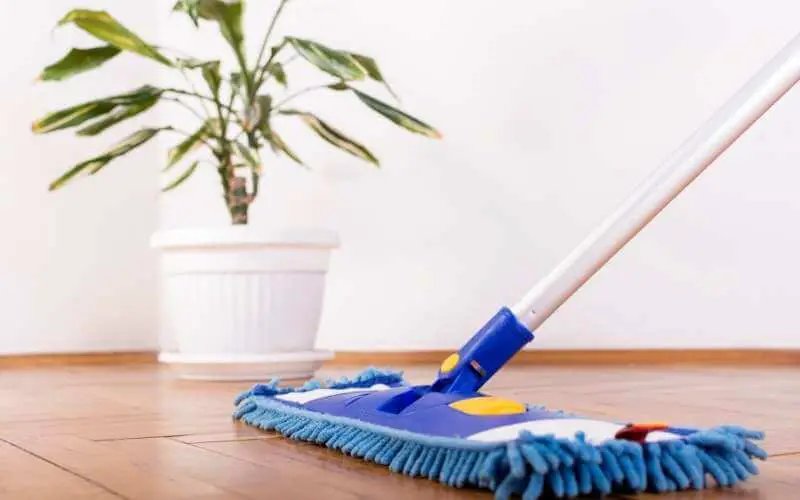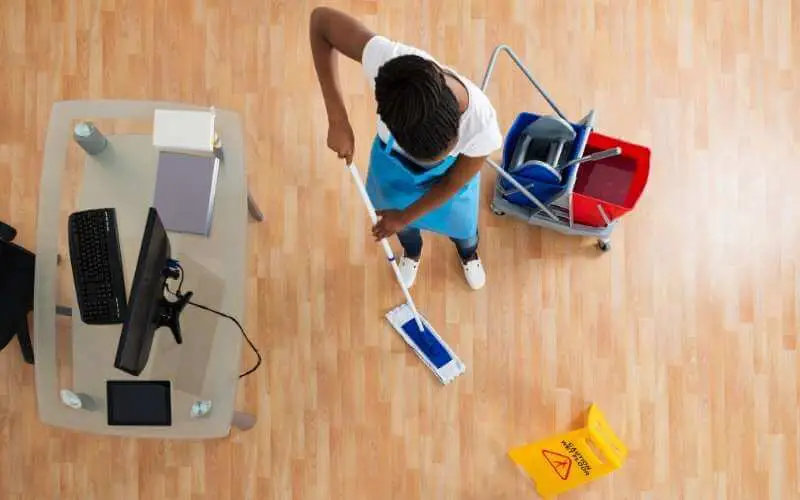Hardwood floors are beautiful and elegant. Hardwood floors mainly used for luxurious properties in the past are now becoming more and more popular among home builders and homeowners alike.
As a base, baking soda dissolves organic compounds like dirt, grease, and other forms of dirt.
In addition, the mineral structure of each baking soda particle provides a gentle abrasive for cleaning without leaving scratches behind. As the name implies, baking soda is original, a harmless kitchen ingredient used mainly for baking and an effective cleaning agent.
Looking for how to remove baking soda residue from wood floor? You can use vinegar, olive oil, hydrogen peroxide, warm soapy water or even plain water to remove baking soda residue from wood floor.
Let’s look in-depth into this.
Is Baking Soda Good for your Wood Floors?
Table of Contents
Baking soda is an effective natural cleanser but is not suitable for hardwood floors.
Because of the abrasive nature of baking soda, it is not ideal for hardwood floors. Some people use it to clean wooden floors after making a paste.
How to Remove Baking Soda Residue from Wood Floor
The residue is remnants. A tiny, sometimes negligible amount of something remains after the central part has been used up.
In this instance, baking powder residue is remnants of baking powder stuck on the wooden floors.
There are several ways of removing baking soda from wood floors. In this article, we’ll list some of them and describe how to get the best result with each of them.
1. Use a damp cloth
One of the ways you can successfully remove baking soda residue from your wood floors is by wiping it clean with a damp clean cloth or sponge.
However, avoid using the same fabric for the wet floor because using the same wet cloth will leave streaks on the hardwood floor.
All you probably need is a damp clean cloth, which you need to wipe over the wood floors after they have been cleaned. In a little bit of time, you will quickly get rid of the baking soda residue.
2. Use olive oil
Using olive oil to get rid of baking soda residue on our wood floors is our second method on this list.
Olive oil is used for many things, such as cooking or frying, but it can also be helpful when trying to remove baking soda residue from the wood floors.
Pour some oil into a bowl, and then use a cloth to wipe it down the floor.
Read: Homemade hardwood floor cleaner with olive oil
3. Using vinegar solution
Vinegar is a house product that can easily clean dirt and residues such as baking soda residue. Get a clean bowl mix equal amounts of warm water and vinegar.
Soak the clean cloth in the vinegar and warm water solution and apply to the wooden floor surface affected by the baking soda residue.
Or you can pour the water and vinegar solution in a spray bottle and spray the affected areas and let it sit for approximately ten minutes.
After that, use a clean cloth to wipe the baking soda residue off the wood floor. The second method is often the most effective in eliminating baking soda residue off the wooden floors.
A vinegar solution can also eradicate urine smells from pets and other offensive odors that sometimes permeate our wooden floors.
4. Use Plain Water
Plain clear water is one of the effective ways to remove baking soda residue from wood floors.
You can always use plain water to eliminate baking soda residue from wood floors. If you have baking soda residue on your wooden floors and plan to remove them, you can always try rinsing them off with clean water until it is sparkling clean.
This would probably take some time and effort, but it works pretty well and is easy to achieve. Always wipe the wood floor with a dry cloth after you’re done rinsing.
5. Use Warm Soapy water
While baking soda might be indispensable as a cleaning agent, it sometimes leaves some residue after using it to clean any wooden surface.
To ensure that your wooden floors do not become sticky after baking soda, wash them with warm, soapy water.
Also, rinse the floor with clean water to avoid leaving soapy residue and avoid dirt accumulation. Clean with a dry cloth until it is properly dried.
6. Hydrogen Peroxide
You can also use hydrogen peroxide to remove baking soda residue from your wooden surfaces, as it is entirely harmless.
A hardwood floor has a surface that has several tiny holes (invisible to the naked eye) which absorb and also release moisture.
Hydrogen peroxide quickly disintegrates these compounds, such as baking soda residue, and pulls them out while drying the floor in the process. Hydrogen Peroxide leaves your hardwood surface looking clean and brand new.
Read: How to clean linoleum floors with hydrogen peroxide
Conclusion
Using baking soda as a cleaning agent is quite helpful and does a fantastic job, but it sometimes leaves a residue that can be pretty challenging to get rid of.
After using the baking soda and mixing it with water or other cleaning agents to get rid of the stain, when you are done cleaning, and the mixture is dried, it leaves the surface looking white and powdery.
This is a result of the baking soda residue. This article highlights several ways on how to to remove baking soda residue from wood floors.
Getting rid of baking soda residue from wood floors is realizable if you follow the various methods listed in this article.
The multiple techniques highlighted in this guide includes using a wet cloth to wipe off the residue, using plain water to rinse off the baking soda residue from the wood floors, hydrogen peroxide, using olive oil, using the vinegar cleaning solution, and last but not the least effective method on how to remove baking soda residue from wood floors is cleaning the wooden floors with mildly soapy warm water and rinsing right after.
This article was written to help you understand every detail about how to remove baking soda residue from wood floor and to make an informed decision when faced with the situation.
We hope you found it helpful; if you did, kindly share it across your entire social media pages.

